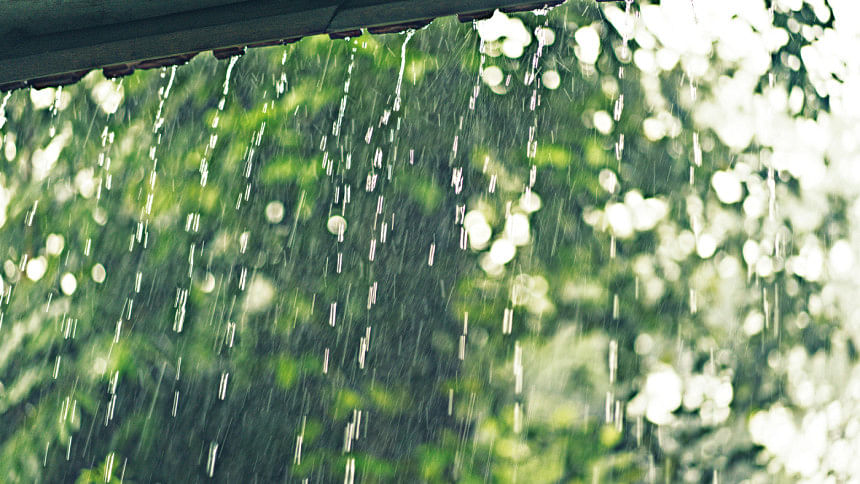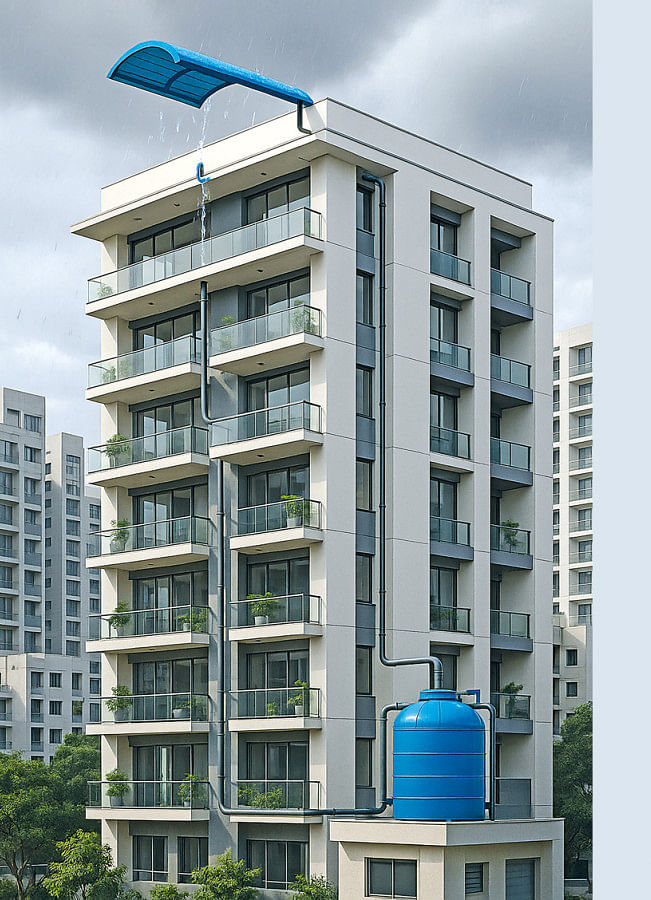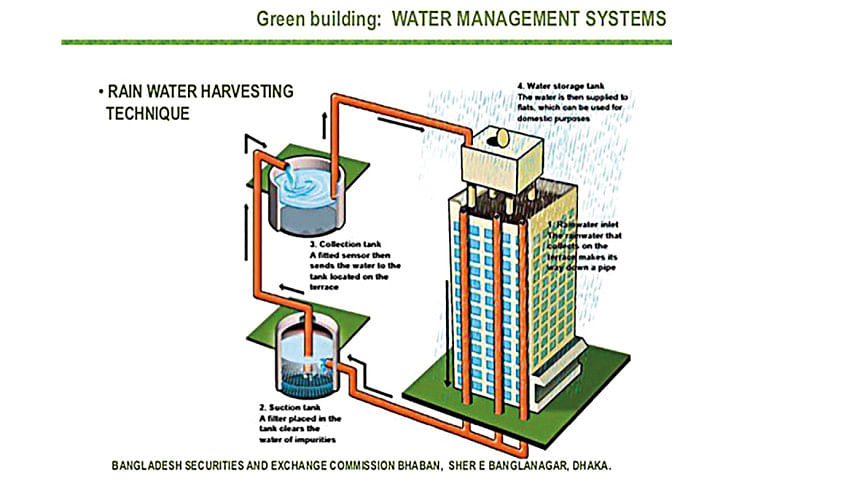Saving every drop: How rainwater harvesting contributes to sustainable urban living

The Bangladesh National Building Code (BNBC) now mandates rainwater harvesting for all new buildings constructed on plots larger than 300 square metres, marking a significant regulatory shift towards water-conscious development.
Have you ever stopped to consider the source of the water that flows from your tap each day? In Dhaka, as in many parts of Bangladesh, the answer lies deep underground. But what was once a reliable source is now under severe strain, due to over-extraction and the failure to protect and recharge natural open water sources.
As the monsoon rains begin to lash the cities, the irony becomes harder to ignore: Bangladesh receives over 2,200 mm of rainfall annually, yet most of it goes to waste—running off into clogged drains and polluted canals rather than being stored or allowed to recharge aquifers. Rainwater harvesting (RWH), an approach that has recently gained notable attention as an alternative water supply source, is now being embraced by a growing number of stakeholders—including government authorities, city dwellers, architects, and real estate developers—as one of the most promising green interventions in sustainable construction.
Rainwater as a resilient resource
The water supply system overwhelmingly depends on groundwater to meet the bulk of domestic demand. This reliance has grown over time as surface water sources—rivers, canals, and ponds—have become increasingly polluted due to the absence of proper sewage and industrial waste treatment, transforming these vital water bodies into dumping grounds. In Dhaka, one of the worst examples of this national trend, the crisis is becoming both more urgent and more invisible. Over 78% of the city's water supply comes from underground sources. Yet groundwater levels are dropping at an alarming rate of 2–3 metres per year, raising the spectre of an acute water crisis in the not-so-distant future.
"Communities must be informed about sustainable water use practices to safeguard groundwater resources for future generations," said Professor Chowdhury Sarwar Jahan of the Department of Geology and Mining at the University of Rajshahi.
To mitigate the looming threat, Professor Jahan emphasised rainwater harvesting—a key element of the green building concept—which can reduce pressure on groundwater by using rooftop-collected rainwater for non-potable purposes, alongside efficient sewage treatment systems to curb the pollution of open water bodies.
In high-density urban centres like Dhaka and Chattogram—where rooftop space is abundant but water remains scarce—this simple equation underscores the need to explore alternative water supply solutions. The Bangladesh National Building Code (BNBC) now mandates rainwater harvesting for all new buildings constructed on plots larger than 300 square metres, marking a significant regulatory shift towards water-conscious development. This move is not just an environmental milestone—it also makes strong economic sense. The unit cost of water for commercial use is more than three times higher than that for residential purposes, making RWH both ecologically responsible and financially advantageous, particularly for large-scale projects.
"Today, architects and engineers in Bangladesh are increasingly adopting runoff coefficient-based calculations to size their rooftop reservoirs and plan climate-sensitive catchment strategies," said Ador Yousuf, Principal Architect and Founder of Vastushilpa.

A Shifting Mindset in Urban Development
In the urban context, the two primary benefits of rainwater harvesting are reliability and water-saving potential. Rooftop rainwater harvesting is slowly gaining ground in both residential and commercial developments, though adoption rates remain relatively low. Nonetheless, numerous new projects have introduced this sustainable approach in their construction. Increasingly, real estate developers are recognising the environmental and economic logic of integrating rainwater harvesting into their projects.
"Our goal is to balance modern design with sustainable practices, ensuring long-term value for both our customers and the environment," said Dr Md Ali Afzal, Managing Director of Krishibid Group.
Krishibid Group Real Estate is embracing green technologies such as rainwater harvesting and solar energy across its developments, reflecting a firm commitment to environmental sustainability. "By integrating efficient water management systems and renewable energy solutions, we are actively reducing the ecological footprint of our projects while delivering added value to our clients," Dr Afzal added.
Since 2018, Rancon FC Properties has placed a strategic focus on building safer, greener, and more resilient structures, addressing the growing challenges posed by climate change. Its projects are guided by a commitment to environmental responsibility and innovation.

The company actively promotes the use of sustainable building materials and systems, including autoclaved aerated concrete (AAC) blocks, energy-efficient windows, solar power, and vertical green walls. Additionally, it incorporates rainwater harvesting systems and on-site water treatment plants in each development to ensure efficient water management. A prime example of this commitment is Rancon Elmore, where rainwater harvesting is featured among the core amenities—underscoring the project's alignment with environmentally conscious design principles.
"Rancon's human-centric approach aligns its projects with the United Nations Sustainable Development Goals (SDGs), responding to the increasing demand for eco-friendly living options," said Tanvir Shahriar Rimon, CEO (Real Estate & Sea Fishing) of Rancon.
Rooted in sustainability, Bay Development Ltd also incorporates rainwater harvesting systems into some of its buildings, including Park Heights and Edgewater.
Incorporating rainwater harvesting is not just about infrastructure; it's about responsibility. At a time when the water table is plummeting and climate variability is intensifying, RWH offers a low-tech, high-impact solution that aligns the goals of environmental preservation with private enterprise.
More importantly, these systems help reduce the waste load on sewage lines, lessen the urban heat island effect, and even foster community ownership of sustainability efforts when integrated into shared housing developments.
With a projected doubling of the urban population by 2035, the challenges of water security, urban sprawl, and environmental degradation will only intensify. But in every challenge lies an opportunity. Rainwater harvesting presents a scalable, cost-effective, and immediate intervention—one that bridges ancient wisdom with modern necessity.
For real estate developers, incorporating RWH is not just a green badge—it is a strategic investment in the future liveability of Dhaka. It is time to treat every drop as a resource and every rooftop as an opportunity.

 For all latest news, follow The Daily Star's Google News channel.
For all latest news, follow The Daily Star's Google News channel. 



Comments